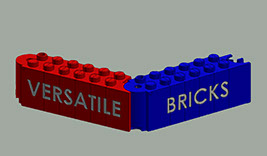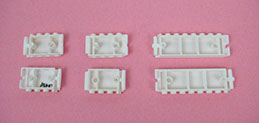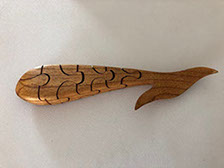
The Story of Versatile Bricks




Prologue to the Story of Versatile Bricks (A Tale of a Fish)
Prologue: A Tale of a Fish
During a vacation to New Zealand in 2006, Paul encountered a 7 piece wooden fish puzzle at a sidewalk sale. The first and second pieces required a third piece to capture the first two pieces together. Very clever. Paul paid out $10 (US) and set the fish aside for retirement.
Paul retired in 2012 and remembered his fish. He tried to scale the puzzle pieces down for a child’s bracelet or belt but it wouldn’t flex enough. He did learn that something like a very wide bicycle chain would bend just fine. Rather obvious.
The next 3 years were spent with 3D printing and some injection molds to develop belt links that would 1) snap together and apart, 2) handle twist and bending, 3) be thin enough for belt loops, etc.
THE History OF VERSATILE BRICKS
BEAMS Feb. 2016
By 2016 it was clear that the market didn’t exist for these digital belts. At the same time, the belt links were not too different from Lego bricks. Thin, single row bricks, although double height, could be developed and attached end to end and then back to back to make relatively long beams. This resulted in a straight, double height beam of any length of 12 pegs or more finished on all sides. Joints are preloaded to eliminate gaps or looseness. Additional work could reduce the minimum length to 8 pegs. This is suitable for straight beams or rectangular grids.
Beam bricks are CONSTANT ANGLE bricks since the angle between the bricks is always 180° during use.
VARIBLE ANGLE BRICKS Nov. 2016
Expecting to fail, Paul surprised himself by developing a hinged joint in a 2x6x2 brick which, when assembled in a straight line, has the appearance of a 2x6x2 Lego brick. This task was possible due to his experience with the belt that uses a similar connection concept.
Paul is an old school guy that works with 2D CAD. The development for the 90° installation was straightforward due to his experience on the belt. Like the belt, all molds for the Versatile Bricks require a top cavity, a bottom cavity and one slide.
The 90° horizontal assembly rotation between bricks preloads the brick to brick joint to reduce beam vertical inadvertent rotation during handling. The bricks are positively connected for rotational angles of 95° to 180°. Preload draws the 2 bricks together by flexing the trunnions that acts as springs. The trunnion flexure is designed into the brick by reducing the spacing of the trunnion centerline to trunnion hole pivot centerline slightly (.010”) as compared to the length of the brick. During the 90° rotation between the links, the trunnion is flexed like an archers bow.
This brick system can be curved horizontally or cantilevered from a structure. This hinged joint is on the vertical centerline of the brick so that the effective length of the brick arrangement is unchanged between straight and curved arrangements. The double height design was chosen to develop a rigid beam using a preloaded joint. Some 2x1x6 bricks were made but the short height doesn’t allow space for the preloading system to flex and the joint remains loose. The 2x2xnn bricks have a good appearance on one side and a less attractive appearance on the backside due to hinge installation and operational requirements. The connection system has a convex extension (hook end) on one end that connects to a concave end (trunnion end) of a second brick that has a vertical trunnion. The concave end is missing a pair of pegs because of the geometry. When formed into polygons, the better appearance side is on the convex, or outside of the polygon. The Versatile Standard Bricks can be used with conventional Lego style bricks. A patent was submitted.
Versatile Standard Bricks are VARIABLE ANGLE bricks. Brick structures can be made with centerline angles of 95° to 180°. These bricks are suitable for joining into polygons of 5 sides or more. For uniform polygons the bricks are of uniform length. Unequal length bricks can be used for other shapes.
Conical polygons can form stepped cones and require polygons of increasing circumference and offset spacers of proper length for alignment and joining of layers. Offset is the perpendicular difference between brick’s longitudinal centerlines from layer to layer. Offset is a constant for polygons of the same number of sides. An inside mandrel was needed to stabilize and align the layers of bricks during stacking of the octagons.
When making tall cones such as a Christmas tree, the number of sides in the polygon needs to transition periodically from top to bottom. A 15 layer tall cone was made that included an 8 to 16-side transition. The horizontal offset spacer length is different between 8 and 16-sided octagons. This difference was accommodated with a slight brick length correction in 2 bricklayers.
All Versatile Bricks have been made using 3D printing except the 2x6x2 that was made by injection molding. The mold has 3 cavity parts including a single slide. All bricks in the inventory can be made using molds of this type.
FIXED ANGLE BRICKS, CONVERGENT & DIVERGENT Jan. 2019
An octagonal ring was converted into a cylinder by adding a curved vertical face to the bricks. The straight peg pattern on each brick was maintained. It was observed that the 45° wedge shaped bricks did not require a full 90° rotation but only 45°. This led to bricks with no vertical or horizontal gaps between them. Curved bricks are CONSTANT ANGLE bricks. They have angled ends and a curved front surface.
A downside to this arrangement is the installation/removal of the 8th brick in a layer. Since the bricks rotate only 45°, each brick is installed from inside the arc of existing bricks. The solution selected was to remove the trunnion from the 8th brick in order to eliminate the constraint that the 8th brick must slide into the next brick before rotation of the final brick. This brick can swing into position if the gap in the ring is increased temporarily. Flexure of the 7 bricks is adequate to produce the required gap. Once the ring is completed, the gaps are eliminated by the spring action of the trunnions. Rings of bricks of 4 pegs per row or more can be expanded temporarily using your fingers. The length of 8 bricks plus the gap formed by trunnion flexure is adequate. Smaller rings will likely require 2 modified trunnion less bricks spaced 180° apart to allow 2 arc sectors to be joined. Once installed, these rings will be constrained by the pegs below and/or above. Stacking layers of cylindrical bricks can build tubes.
These gent and divergent bricks are possible in this style. Convergent bricks reduce the circumference of the top layer by 1 peg per brick while divergent bricks increase the circumference of the top layer by 1 peg per brick.
Stacking layers will form a smooth exterior surface with pegs visible only at the top of the stack. This brick system eliminates the need for offset spacers or mandrel.



COMBINED BRICKS Aug. 2019
Curved bricks can be combined with Versatile Standard Bricks as a CONSTANT ANGLE arrangement of bricks.
The end connectors for the type 2 and type 3 bricks, although different with regard to the trunnion support, have been modified to connect together. Four example, 8, 45° cylindrical bricks connected to 8 Versatile Standard Bricks can form a square with 90° rounded corners. At least 10 different other closed combinations can be assembled with these 16 bricks.
Since the curved bricks provide for a complete circle and the straight bricks provide no curvature, the ring will be gapless and require a last/first brick without a trunnion. Exchanging fixed angle corner bricks for the curved bricks to form rectangles, etc, is possible.
GENERAL INFORMATION
For VERSATILE STANDARD, CURVED AND CONBINATION bricks, all styles of these bricks of equal length can be stacked together. For example, octagon rings of the standard, curve, convergent and divergent can all stack together since the all have the same 2 sets of parallel studs and receptors.
Versatile Bricks is likely the first toy brick system design for assemblies based on a cylindrical coordinate system.